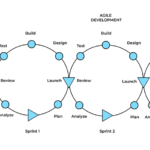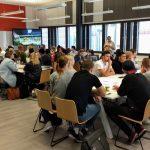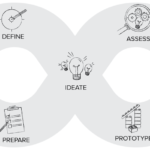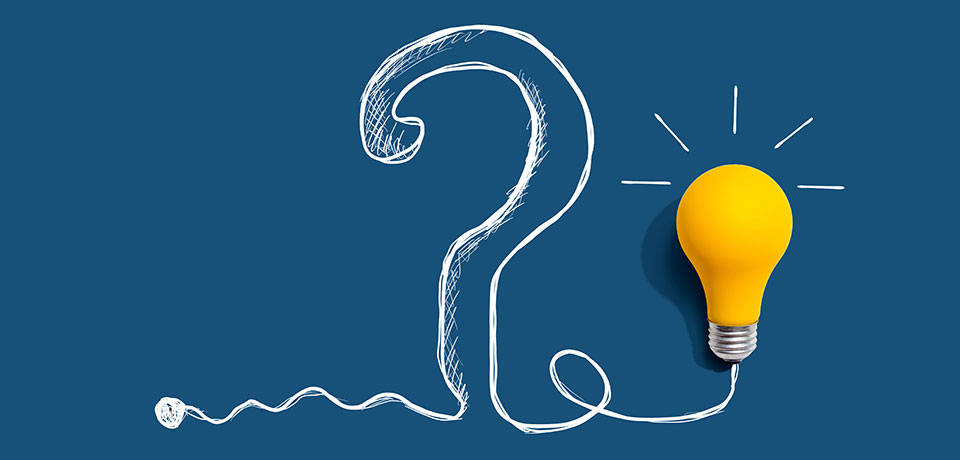
Jari Jussila, Sanna-Maaria Siintoharju & Ricardo Galiot
Many people consider themselves experts in design thinking. Nevertheless, there is always something to learn from other experienced design thinkers. A better understanding of the design thinking mindset and the common misconceptions about design thinking can help get the best out of design thinking. One aspect of the Design Factory Global Network Research (DFGN.R) conference organised in Ankara in October 2023 was to exchange experiences and ideas on design thinking. This article presents insights from the research and workshop on design thinking from DFGN.R, introduces a tool to test design thinking mindset and case examples to illustrate design thinking mindset development.
Design thinking has been defined as a mindset and an approach to developing innovative and human-centred solutions to complex problems (Wrigley et al., 2020; Castañeda et al., 2023). In a DFGN.R design thinking workshop, Matteo Vignoli (2023) outlined two typical mistakes when people apply a design thinking approach. One typical mistake is that people focus on thinking only, and the doing part is neglected. This means that designers ideate the solution without any observations of the users’ needs and problems, and do not test their ideas with real users of the solution. This is a very egocentric approach, where the designer thinks or assumes they know what is best from the user’s point of view without consulting the user. Ultimately, following only a thinking approach, there is no way of knowing whether the solution has any value for the user.
Another common mistake is to focus only on the doing part of the design thinking approach. This mistake can lead to solutions built based on observations of the users’ problems and needs and then experiments on the users without proper framing or reframing of the problem. Ignoring the thinking process typically leads to building the solution based on the first idea that comes into the designer’s mind without considering alternative approaches of making the user’s life more pleasant and straightforward, and going beyond the observed problems to a broader perspective of creating value via the solution. As an analogy, only a part of human potential is utilised in the process, when only the hands (doing) or the head (thinking) are ever actually used. Figure 1 illustrates the design thinking cycle as a whole and the thinking and doing parts that are essential to the success of the process.
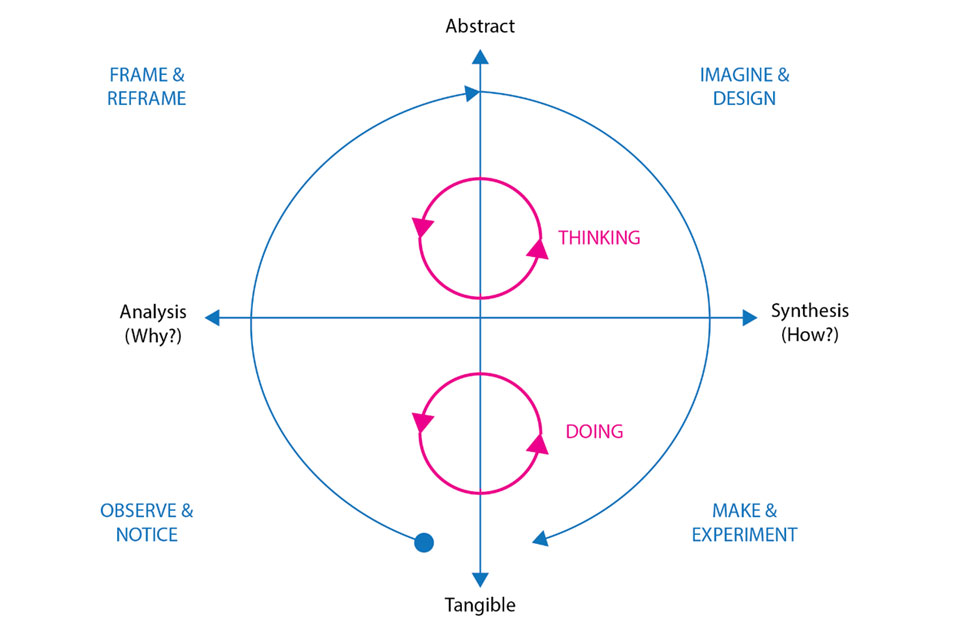
Human-centredness is sometimes misconceived in design thinking. Human-centredness in design thinking does not mean that everything is centred on what the designer thinks. In actuality, human-centredness is about understanding human behaviours, needs and values (Howard & Davis, 2011), which requires design. Being user-centred does not mean asking customers what they want but discovering what they need (Koh, 2012). When being truly human-centred, co-creating with customers is not optional; it is a necessity (Liedtka, 2011).
Design is not just about doing something. The design thinking mindset impacts the quality of design in many ways. For instance, if a designer is unwilling to change the status quo, the desire to create value with the final solution or impact the people around him (Dosi et al., 2018), the results of doing so will likely be less valuable. If the designer does not have creative confidence (Dosi et al., 2018) and innovation competence (Hero et al., 2021; Lahdenperä et al., 2023), the results are less likely to be novel and innovative. This essentially means that a ‘mechanical’ performance of the design thinking process is not a guarantee of reaching successful results, e.g., products or services that are sustainable, desirable, feasible and viable. Cultivating a design thinking mindset and developing design skills can, however, increase the likelihood of achieving good results.
Design thinking mindset
All this might be familiar to you, but have you ever evaluated and reflected on your design-thinking mindset? A handy and easy-to-use tool to increase your design thinking mindset self-awareness is the Design Thinking Mindset survey (Unibo, n.d.). With the survey, you can evaluate your design thinking mindset through the following ten dimensions: 1) uncertainty and risk, 2) empathy, 3) holistic thinking, 4) collaboration and diversity, 5) learning orientation, 6) experimentation, 7) critical questioning, 8) abductive thinking, 9) creative confidence, 10) optimism to create value (Vignoli et al., 2023).
The Design Thinking Mindset survey can function as a personal and team reflection tool that can help to develop a design thinking mindset collaboratively. To serve that purpose, a few case examples of design thinking in teaching are outlined and reflected upon.
Case example of design thinking in HAMK Design Factory
HAMK Design Factory in Häme University of Applied Sciences (HAMK) has organised Design Sprints for the last three years to orient and familiarise students with design thinking. Design Sprint evolved within Google Ventures (Banfield et al., 2014) and has also been a popular approach in higher education to get first-hand experience on design thinking in a 3–5-day sprint format. The Design Sprint was initially developed as a five-day process for answering critical business questions through design, prototyping and testing ideas with customers. It has been found to be an effective way to learn design thinking in practice. Although it has been adapted to formats shorter than five days, it is, by design, a dedicated and intense face-to-face collaboration without the usual work or family-related distractions that often appear in online settings.
Reflecting on the past three years, one of the biggest challenges has been the principle of ‘getting out of the building’ to better discover users’ needs and follow the human-centred design approach of designing with actual – not imagined – people (Zeivots et al., 2021). Many students are initially hesitant to start interviewing, surveying, or observing users and would prefer to ideate solutions without exposure to real users and ‘getting their hands dirty’. However, this is an essential part of learning and critical to understanding and getting hands-on experience with what design thinking is about. As in Figure 1, the design cycle begins with observing and noticing and then proceeds to framing and reframing the problem based on the results of the user research. Many students would like to jump into ideation directly. Perhaps they already have a solution in mind that they would like to work on for three to five days without the hassle of getting in touch with users and trying to understand what they need.
Based on a previous study (Jussila et al., 2020), students initially tend to think that the result of the Design Sprint or any other similar student project will be a presentation they deliver for the customer at the end, not realising that they have to go through the entire design thinking cycle of user research (observations, interviews, surveys, etc.), problem framing and reframing, ideating, prototyping and testing their prototypes with users. While in educational Design Sprints, there is typically a presentation at the end – it should, however, include all the learnings from the design thinking cycle, i.e., what did the users need? How was the problem redefined from the user perspective, what were the solutions ideas and what kind of prototypes were developed and showcased to gain feedback on the ideas from the users? How were the solutions improved based on the received feedback? If students cannot answer these questions in the end, then the design thinking cycle has not been fully completed, and the lessons learned from the Design Sprint are only partial.
Design thinking in HAMK Diili
HAMK Diili (Deal) is a 5-day design sprint concept introduced by HAMK Entrepreneurial University, where local businesses bring their business challenges to the students, expecting innovative outcomes in return. Typically, businesses are looking for new business ideas or services which may increase their revenue. During the first HAMK Diili-day, businesses introduce their challenges, and students empathise, define, ideate, prototype, and test their ideas during the week following the design thinking process (Figure 1). The week ends with finals, where local companies come to a live session to hear about all the innovative student concepts and to select winners in collaboration with HAMK teachers. HAMK also rewards the most innovative ideas. As the outcome of the week, we typically end up with concepts that have been visualised as presentations, and some student teams also demonstrate low-fidelity prototypes of the solution they have developed during the week.
At HAMK, we have adapted the concept in several different degree programmes. Based on the most common pitfalls in the design thinking process introduced by Matteo Vignoli (2023), we can reflect on the challenges students typically face in the HAMK Diili concept. Considering that in the design thinking process, customer experience and user testing are central, this has sometimes been very difficult for students. When students fall in love with their ideas, instead of testing them on the target audience, there is a risk that the whole idea is built only on assumptions. By not asking for the target audience’s opinions on their ideas, students are limiting themselves, and they are not taking any risks or plunging into the challenge.
Matteo Vignoli (2023) stressed at his workshop that risk-taking is a prerequisite to innovative ideas. Completing the design thinking cycle requires students to redefine or reframe the challenge and find an innovative point of view for design. When this is not followed, students are operating only in the doing phase, moving forward quickly with an idea without rethinking the challenge presented by the company. Imagine and Design phase in the design thinking cycle can also fall short as students feel more comfortable and safe remaining in the Make and Experiment phase. This can be observed as a lack of questioning of the existing state of affairs and a lack of future thinking. While focusing only on the Make and Experiment phase, the improvements tend to be incremental, avoiding radical innovation and upsetting the current situation.
Experimenting requires practice, but we have also seen student teams experimenting successfully and framing and re-framing their problem based on the results of the experiments. We have also witnessed innovative solutions where the whole design thinking cycle was applied instead of remaining only on the upper or lower part. Those ideas are usually taken into a local business’s everyday life. All this requires a lot from students. Design thinking is hard, and taking the whole process seriously, but at the same time, allowing yourself to find crazy ideas usually pays off.
Sustainability sense-making and marketing prototyping
At HAMK’s International Business Degree Programme, students often journey into a learning experience that aims to connect work life and the contextual challenges of a globalised world. This linkage demands that the learners develop competencies in sustainability practices and the applicability of business solutions that often require their decoding of complexity. Therefore, in facing the need to tackle wicked problems in the classroom, design thinking practice has become a meaningful methodological approach, particularly in two courses that deal with innovation, entrepreneurship and marketing positioning.
During both courses, students work on intensive iterative weeks following the double diamond process from end to end. The double diamond is a design thinking framework developed by Design Council (n.d.) to guide and structure the design process by dividing it into four phases Discover, Define, Develop and Deliver (Figure 2).
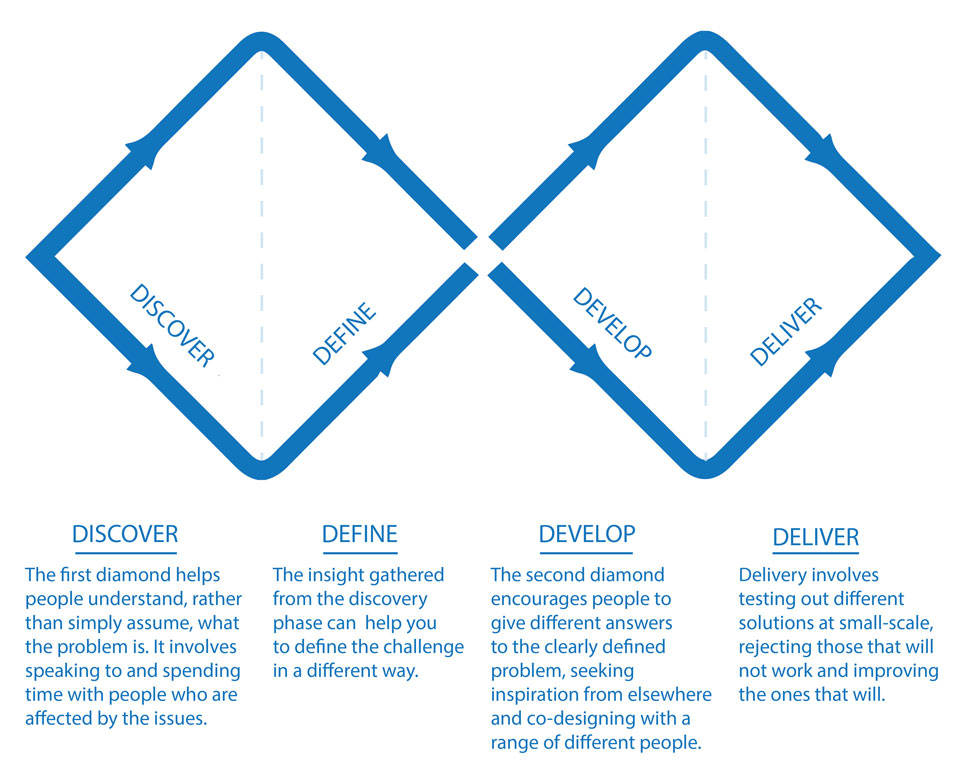
In line with the previous cases presented, getting out of the classroom, hence interacting with real humans, either potential users or even the challenge owners, has been one of the most challenging milestones for students. Nonetheless, the challenges are slightly different in each of those two courses.
Finding Business Opportunities Through Innovation is a course in which students explore the 17 United Nations Sustainable Development Goals as the original starting brief. Most students get in touch with design thinking for the first time during this course. They are challenged with exploring one of the goals and understanding context and empathy, embodying one of the two functions of the new needs of design presented by Manzini (p. 35, 2015): sense-making.
The notion of multi-faceted problems and diversity as a force for solution-building are introduced. In doing so, the learner-designer is invited to get out of the classroom, searching for information for better empathy mapping. Empathy via design thinking tools evolves into knowledge construction (Köppen & Meinel, 2014). However, identifying, contacting and interviewing a natural person becomes a source of anxiety that builds up as the moment approaches. The role of the teacher-facilitator and the classroom in navigating ambiguity becomes essential as those are anchors that the students hold during the climbing. In analysing sustainable education, Geitz and De Geus (2019) refer to this as the dialogical process described by Biesta, where the learner and teacher communicate in a learning environment, providing meaning to that space and the space in which the learning happens, also outside the classroom.
While fear seemed to be a blocker at first, once addressed, students consistently reported the impact of the experience. Their collective design journeys turn focused, tangible and real. They also start accepting ambiguity as an inherent part of the creative process, perhaps still needing to fully understand how much value will be delivered but increasing their creative confidence.
Whereas empathy becomes the driver of change and the need to get out of the classroom, in the following case, a marketing course within the same programme, students work on a company problem that leads to a series of prototypes that mandate sufficient evaluation. As expressed before, the challenge of getting out of the classroom is, in this case, different. Students work on a case presented by a company; after they reframe, the continuation with the delivery phase leads them to the execution of a creative idea. They produce a tangible solution that should be put out there for the test. In this testing, they are confronted with a dilemma: they might have created something less effective than they thought. A usual issue of creators resisting to ‘kill their darlings’.
Design culture is, in a way, nurturing and empathetic with the learner and the process. Its iterative nature recognises that the production should be malleable and that there is always room for improvement since getting things right on the first try is uncommon. Tolerance of failure becomes another source of apprehension, a challenge engraved in creative production. Resistance becomes the norm, yet the iterative process allows them to compare with the next iteration, channelling their recently acquired competence to bounce back through self-reflection so they can continue with the process. Therefore, applying design thinking methodologies to the learning process not only helps them explore the logic of stages of business development but also embraces a sustainable education by supporting students in developing adaptability and resilience, connecting with the ideas that design is socially situated as it works with value frameworks and sense-making (Geitz & De Geus, 2019).
If those two presented cases demand what Jamal et al. (2021) defined as external empathy, another opportunity to put themselves in the shoes of others lies in what the same authors call radical collaboration. The added perspective to the design thinking ‘mindset’ set the lens on multidisciplinary teamwork, requesting that members operate in acceptance of diverse perspectives, often leading to the need to explore different cultural or professional backgrounds, all in line with the Design Thinking Mindset survey.
Conclusions
How do we know if our teaching improves students’ design thinking mindset and innovation competence? Well, we do not, unless we study it. Previous research on Product Development Projects (PDPs) organised by the HAMK Design Factory indicates that the students experienced an increase in their competencies in constructing and applying knowledge, and collaboration and communication during the PDP implementations (Lahdenperä et al., 2023). This year, we have shifted our focus to studying the development of innovation competence of students in Design Factory and design-based education (DBE) implementations. The validated design thinking mindset scale (Vignoli et al., 2023) is another instrument we are considering applying in the future, and this may also be an excellent thesis topic for a student of this or some related field. Meanwhile, anyone interested can evaluate their design thinking mindset using the tool introduced in the article.
Authors
Jari Jussila, D.Sc. (Tech.), is Director of HAMK Design Factory and Principal Research Scientist at Häme University of Applied Sciences (HAMK). His research is focused on design-based education and university-industry collaboration.
Sanna-Maaria Siintoharju, M.Sc. (Economics) is a Senior Lecturer and Project Manager at HAMK Design Factory.
Ricardo Galiot, MBA and M.A. (Media and Innovation) is a Senior Lecturer in Sustainability Leadership at HAMK’s Management in Sustainable Business Master’s Degree Programme.
References
Castañeda, S.S., Reichert, D., Bauknecht, J., Ackerman, C. (2023). Mindset muscle training – fostering the design thinking mindset in organizations. In A. Kocsis, A. Gönenç Sorguç, A. Krebs, L. Iandoli, & M. Vignoli (eds.), 2nd Design Factory Global Network RESEARCH CONFERENCE : Contributions for ‘Designing for Multiplicity’ October 5th-6th 2023 (pp. 44–47). http://urn.fi/URN:ISBN:978-952-64-9638-2
Design Council. (n.d.). The Double Diamond. A universally accepted depiction of the design process. Retrieved 21 November 2023 from https://www.designcouncil.org.uk/our-resources/the-double-diamond/
Dosi, C., Rosati, F., & Vignoli, M. (2018). Measuring design thinking mindset. In D. Marjanović, M. Štorga, S. Škec, N. Bojčetić, & N. Pavković (eds.), DS 92: Proceedings of the DESIGN 2018 15th International Design Conference (pp. 1991–2002). https://doi.org/10.21278/idc.2018.0493
Geitz, G., & De Geus, J. (2019). Design-based education, sustainable teaching, and learning. Cogent Education, 6(1), 1647919. https://doi.org/10.1080/2331186x.2019.1647919
Hero, L. M., Pitkäjärvi, M., & Matinheikki-Kokko, K. (2021). Validating an individual innovation competence assessment tool for university–industry collaboration. Industry and Higher Education, 35(4), 485–496. https://doi.org/10.1177/09504222211017447
Howard, Z., & Davis, K. (2011). ). From Solving Puzzles to Designing Solutions: Integrating Design Thinking into Evidence Based Practice. Evidence Based Library and Information Practice, 6(4), 15–21. https://journals.library.ualberta.ca/eblip/index.php/EBLIP/article/view/12195/9399
Jamal, T., Kircher, J., & Donaldson, J. P. (2021). Re-Visiting Design Thinking for Learning and Practice: Critical Pedagogy, Conative Empathy. Sustainability, 13(2), 964. https://doi.org/10.3390/su13020964
Jussila, J., Raitanen, J., Partanen, A., Tuomela, V., Siipola, V., & Kunnari, I. (2020). Rapid product development in university-industry collaboration: Case study of a smart design project. Technology Innovation Management Review, 10(3). http://doi.org/10.22215/timreview/1336
Koh, S. (2012). Design Thinking: A Culture of Innovation. Social Space, 30–33. https://ink.library.smu.edu.sg/lien_research/95
Köppen, E., & Meinel, C. (2014). Empathy via design thinking: creation of sense and knowledge. In H. Plattner, C. Meinel, & L. Leifer (eds.), Design Thinking Research : Building Innovators (pp. 15–28). Understanding Innovation. Springer. https://doi.org/10.1007/978-3-319-06823-7_2
Lahdenperä, J., Jussila, J., Järvenpää, A.-M., & Jumisko-Pyykkö, S. (2023). Developing students’ innovation capability through interdisciplinary product development projects for industry. In A. Kocsis, A. Gönenç Sorguç, A. Krebs, L. Iandoli, & M. Vignoli (eds.), 2nd Design Factory Global Network RESEARCH CONFERENCE : Contributions for ‘Designing for Multiplicity’ October 5th-6th 2023 (pp. 44–47). http://urn.fi/URN:ISBN:978-952-64-9638-2
Liedtka, J. (2011). Learning to use design thinking tools for successful innovation. Strategy & Leadership, 39(5), 13–19. https://doi.org/10.1108/10878571111161480
Manzini, E. (2015). Design, when everybody designs. MIT Press. https://doi.org/10.7551/mitpress/9873.001.0001
Unibo. (n.d.). Measure your Design Thinking mindset. Retrieved 22 November 2023 from https://designthinkingmindset.unibo.it/
Vignoli, M. (2023, October 5). Measuring Design Thinking [Workshop]. Design Factory Global Network research conference, Ankara, Turkey.
Vignoli, M., Dosi, C., & Balboni, B. (2023). Design thinking mindset: scale development and validation. Studies in Higher Education, 48(6), 926–940. https://doi.org/10.1080/03075079.2023.2172566
Wrigley, C., Nuseum, E., & Straker, K. (2020). Implementing Design Thinking: Understanding Organizational Conditions. California Management Review, 62(2), 125–143. https://doi.org/10.1177/0008125619897606
Zeivots, S., Vallis, C., Raffaele, C., & Luca, E. J. (2021). Approaching design thinking online: Critical reflections in higher education. Issues in Educational Research, 31(4), 1351–1366. https://www.iier.org.au/iier31/zeivots.pdf

